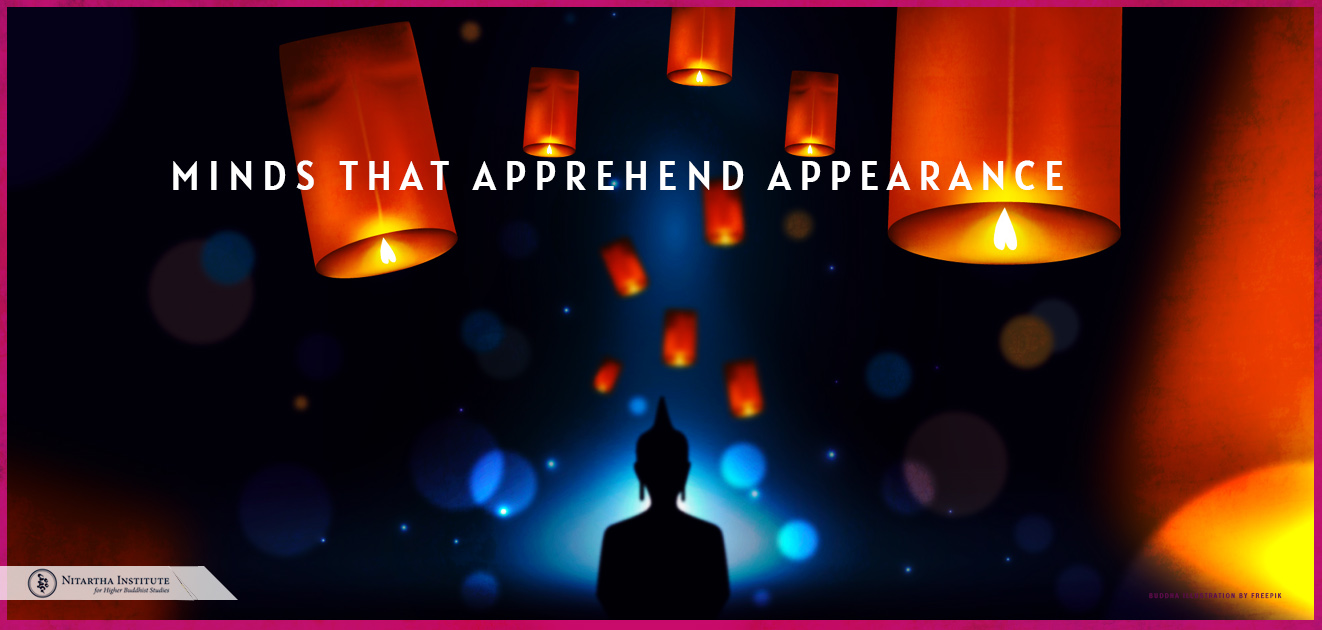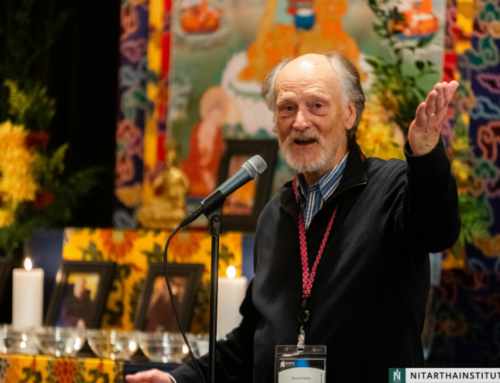This excerpt is copyrighted material, please do not use or copy without written permission from Nitartha Publications.
The following is an excerpt from Minds that Apprehend Appearance by Acharya Sherab Gyaltsen. This is included in the sourcebook we use in our Mind & its World II course. This course completes the Classification of Mind (Lorik) root text, from the tradition of Pramāna or Buddhist epistemology that students begin in Mind and Its World I.
MINDS THAT APPREHEND APPEARANCE
Acharya Sherab Gyaltsen
The second main section of the Lorik text is the specific analysis of the essential modes of engagement of the mind. It has five subsections. The first is minds that apprehend generalities and particulars, which we have completed. We are now looking at the second subdivision, and it is divided into two sections: inclusive engagement of appearances and eliminative engagement of conceptions.
INCLUSIVE ENGAGEMENT OF APPEARANCES
Minds that apprehend appearance and elimination has two parts: inclusive engagement of appearances and eliminative engagement of conceptions.
Definition of Inclusive engagement of appearances
A mind that directly engages its specific object without excluding its opposite is an inclusive enager. For example, an eye consciousness apprehending a flower is an inclusive engager because it apprehends and directly engages its specific object, the flower, without excluding its opposite, that is, what are not flowers.
From the view of the inclusive engagement of appearances, the word “appearances” refers to objects for a nonconceptual consciousness. The inclusive engager cognizes the object through just the mere appearances of it. Through just the mere appearance of the object, the action of cognizing is completed, which means that this mind does not do anything else. Its engagement of the object does not exclude anything; it does not need to go through the process of excluding everything that the object is not. It is simply, on the basis of the mere appearance alone, that the object is engaged. Its action is completed through just seeing of the object. You might wonder if all instances of direct valid cognition are inclusive engagers of appearances. Yes, they are. Consciousness can engage an object in two ways: either as an inclusive engager of appearances or as an eliminative engager of conceptions. All direct valid cognitions are inclusive engagers, but not all inclusive engagers are direct valid cognizers, as in the case of wrong cognition. That would still be an inclusive engager, but it would not be a direct valid cognition.
Divisions of Inclusive Engagement of Appearance
This has three modes: First is the actual mode of being of the object, that is, the way the object is. Second is the mode of apprehension of the mind, which is the perceiving subject. Third is the concordance of mind and object, the way in which the perceiving subject and it object relate in a concordant way.
Khenpo Rinpoche wrote the verses in this presentation. The verses are in the form of a reasoning, which was done to make the whole thing easy.
Actual Mode of Being the Object
The first line is the subject: “Entities that exist as actual objects.” Actual objects are specifically characterized phenomena, or ultimately existent objects. The predicate is the second line: “Exist without evident and nonevident aspects.” The reason is the last two lines: “One entity does not exist as different entities / And different entities do not exist as one.”
We will use an eye consciousness apprehending these flowers as our illustrating example. When the eye consciousness directly sees these flowers, the single specifically characterized phenomenon “flowers” does not exist as different entities. It exists as something single. When the eye consciousness sees the flowers, it does not see half of them and then not half of them. They exist as one single thing, and they are seen as that. This is the meaning of the line “[They] exist without evident and nonevident aspects.” If the specifically characterized phenomenon did exist as different entities, you would only see one and you would not see another. You would see some aspects clearly and some not clearly. But, in fact, when the eye consciousness looks at the flowers, it just sees the single entity, the single specifically characterized phenomenon, just as it is.
A specifically characterized phenomenon, which is a thing that exists clearly from its own side, is exactly what it is. If it is single, it is single; if it is single, it does not exist as different entities. Different entities do not exist as one. Therefore, when an inclusive engager apprehends its specific object, it sees it clearly as it is. It apprehends the object just as it is, without obscuration. It is not some parts of it are not clear or obscured. It sees specifically characterized phenomena just as they are.
Mode of Apprehension of the Mind
The subject is part of the first line: “in inclusive engagement.” The predicate is the fourth line: “In engagement through appearance, there is no remainder.” The reason is the second and third lines: “One entity does not appear as different entities / And different entities do not appear as one.” The example is shown in the first line: “Sense direct valid cognition.”
The first line says: “In inclusive engagement, such as sense direct valid cognizers.” “Such as” includes mental direct valid cognition, self-aware direct valid cognizers, and so on. These are all inclusive engagers.
For an inclusive engager, one entity—one specifically characterized phenomenon, which is its specific object—will not appear as different entities. Different specifically characterized phenomena will not appear as something single. Therefore, in engagement through appearance, there is no remainder.
An inclusive engager directly engages its specifically characterized phenomenon without something being left over that is not seen. When it directly engages with the object, there is not some part of the object left over somewhere, that is not seen. It engages the whole object. It sees the whole thing. When you have an eye consciousness apprehending something white, the object is the white thing that is seen. When this white object is directly seen, the whole thing is seen. It is not as though the eye consciousness only sees half of it and the other half is not seen.
In the context of Madhyamaka, bodhisattvas abiding on the first bhumi directly realizes emptiness. The mind of such a bodhisattva is an inclusive engager. It is yogic direct valid cognition that is realizing emptiness, and when this emptiness is realized, nothing is left out. It is not as though half of the emptiness is seen and there is another half that is not seen. For this reason, it is said that the emptiness realized by the three types of noble beings, shravakas, pratyekabuddhas, and bodhisattvas, is the same. When emptiness is realized, the emptiness of a self of the individual and the emptiness of the self of phenomenon is realized. From the view of the emptiness that is realized, nothing is incomplete, and the distinction made from one bhumi to another is simply whether the familiarization or habituation to that emptiness has been completed or not.
From their own side, all compounded phenomena are impermanent. When one understands this through reasonings and becomes habituated to that understanding, and finally directly realizes the impermanence of all compounded phenomena, it is not as if one realizes half of it and does not realize the other half. It is not that some part of impermanence is realized but another part is not realized. If one realizes impermanence, one realizes that all compounded phenomena are impermanent. It is for this reason that Aryadeva said that when one realizes the emptiness of one thing, one realizes the emptiness of all.
“Object and subject” refers to a specifically characterized phenomenon and a direct valid cognition. No confusion is present. Nothing mistaken occurs. Then we have two reasons why.
Concordance of Mind & Object
“Object and subject” is the subject of the reasoning. The third line where it says “without any confusion” is the predicate. So we are saying, “Object and subject are without any confusion.” Then two reasons are given. The first one is the first two lines: “In whatever way an object’s features abide. In that same way are they apprehended by mind.” the second reason is the second half of the last line: “Abide interdependently.”
“Object and subject” refers to a specifically characterized phenomenon and a direct valid cognition. No confusion is present. Nothing mistaken occurs. Then we have two reasons why. First because “in whatever way an object’s features abide, in that same way are they apprehended by mind.” If we have one object, there will be one perceiving subject. For example, when an eye consciousness apprehends a flower, it sees a flower. It does not apprehend something else—which brings us to the last line: “abiding in mutual dependence”—because the object and perceiving subject are dependently originated. If the object is a flower, the apprehending consciousness will apprehend a flower, or an aspect of a flower; it will not apprehend a piece of paper or something. Therefore we have this statement: Object and subject are without any confusion. There is nothing mistaken in their relationship. In whatever way an object’s features abide, they are apprehended by mind in that same way because they abide in mutual dependence.
Let’s use a mirror as an illustrating example. A mirror is able to have reflections appear within it. There is an interdependent relationship between the object and the mirror in which it is reflected. If we have an external object and we have a mirror, the form can be reflected within the mirror. If we do not have a mirror, but we do have an object, of course, the object cannot be reflected. If we have a mirror, but we do not have an object, nothing will be reflected in the mirror. In the same way, the perceiving subject and its objects have an interdependent relationship. In the case of an eye consciousness apprehending a flower, we need the observed object condition of a flower and an eye consciousness to be present for the apprehension of a flower to occur. Without the flower, there will not be an eye consciousness that apprehends a flower. The two abide in mutual dependence, or they exist in a relationship if interdependence. That is why the text says that in whatever way the object abides, it is apprehended directly by mind.





